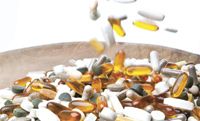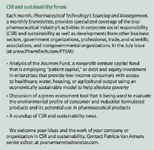Augmenting Excipient Functionality
Excipient manufacturers expand their products, services, manufacturing capacity, and technology positions.
Excipients play an important part in a pharmaceutical formulations and finished drug products. Like other sectors in the pharmaceutical–ingredient value chain, excipient manufacturers are addressing product demand and technical challenges in formulation development and manufacturing through product and service enhancements, capacity expansions, and select acquisitions. These changes are occurring as relative moderate growth is projected for the global excipients market.

Patricia Van Arnum
Crunching the numbers
The global excipients market was valued at $3.5 billion in 2006, according to an analysis by BCC Research. The market is expected to increase at a compound annual growth rate (CAGR) of 3.8% through 2011, when it will reach $4.3 billion. The global excipients market is broken down into three major segments: organic chemicals, inorganic chemicals, and United States Pharmacopeia (USP)-grade water (1).
Carbohydrates represent the largest share of global organic excipients on a value basis, followed by petrochemicals, oleochemicals, and proteins. Carbohydrates account for 39%, or $1.2 billion, of the global organic excipient market, based on 2006 data. Petrochemicals account for 30.3%, or $941 million. Glycols and povidones are the leading petrochemical excipients. Oleochemicals account for 28.3%, or $880 million. Proteins represent a small percentage, only 2.2%, or $68 million, according to BCC. (1).

(IMage: KATHLEEN BRENNAN, BRAND X PICTURES, GETTY IMAGES)
Inorganic chemicals used as pharmaceutical excipients include calcium salts, halites, metal oxides, and silicates. Calcium salts hold 73.2%, or $266 million, of the global inorganic excipients market, according to BCC. Halites and metal oxides each comprise 8.5%, or $31 million, of the global market for inorganic excipients. Silicates account for 4.8%, or $17 million, of the global market for inorganic excipients. Other inorganic excipients account for 5%, or $18 million, according to BCC (1).
Technology challenges
Excipient manufacturers must continually adapt their products and technology to resolve problems in formulation development. Water solubility presents an ongoing challenge. Industry figures estimate that approximately 40% of the drugs on the market and nearly 60% of drugs in development may be classified as poorly water-soluble. Drug–polymer solid solutions and solid dispersions are approaches that can be used to address the problem of drug solubility (2).
In both a solid solution and solid dispersion, at least one active ingredient is dispersed in an inert matrix. In solid dispersions, separate regions of drug and polymer are in the matrix, and the drug may be crystalline or it may be in an amorphous state (2). A solid solution exists when the drug–polymer miscibility is attained at the molecular level, and the drug exists in its amorphous form (2).
Pharmaceutical polymers are used to create this matrix. Commonly used polymers include polyvinylpyrrolidones, polyvinylpyrrolidone-vinyl acetate copolymer, and cellulosics (2). Polymer selection is based on physicochemical and pharmacokinetic factors. These solid solution/dispersions can be produced by many methods, including spray drying, hot-melt extrusion, melt congelation, spray freezing into liquid, and nanocrystal technology (2). Some examples of commercial drugs using solid solutions/solid dispersions are: solid solutions of lopinavir and ritonavir in a polyvinylpyrrolidone-vinyl acetate copolymer in Kaletra (Abbott Laboratories, Abbott Park, IL); Sporanox (Janssen Pharmaceutica, Titusville, NJ), a solid dispersion of itraconazole in hypromellose that has been layered onto sugar spheres; and Intelence (Tibotec, Yardley, PA), an amorphous, spray-dried solid dispersion of etravirine, hypromellose, and microcrystalline cellulose (2).

Formulation development forum: on-demand drug delivery
Several excipient manufacturers recently launched services and products to tackle the problem of poorly water-soluble drugs. In October 2009, International Specialty Products (ISP, Wayne, NJ) launched an initiative in drug-solubility and formed an alliance for hot-melt extrusion technology with Coperion (Stuttgart, Germany), an equipment manufacturer, including extruders. Coperion is providing equipment for testing and expertise in physical systems that use extrusion. ISP is providing expertise in ingredient technology such as polymers and disintegrants. The alliance is focusing on ways to improve scale-up of these processes for commercial production.
Hot-melt extrusion technology features combinations of drugs, polymers, and plasticizers into various final forms to achieve designated drug-release profiles, according to ISP. Individual components are mixed and processed in a controlled environment of temperature and shear within the extruder to create the final material. Hot-melt extrusion is used to prepare granules, sustained-release tablets, and transdermal and transmucosal drug-delivery systems. Some potential benefits include fewer processing steps, no requirements on the compressibility of the drug actives, more uniform dispersion of the drug particles, and improved bioavailability of poorly soluble drug actives.
In October 2009, ISP expanded its research and development (R&D) facilities in Hyderabad, India, to create a Solubility Center of Excellence as part of its drug-solubility initiative. The facilities in Hyderabad serve as a focal point for the R&D for the solubilization of drug actives and focus on the use of polymers, disintegrants, and cyclodextrin chemistry as tools to achieve improved drug solubility and bioavailability in oral and parenteral pharmaceuticals. The center also focuses on solid-dispersion technology for drug formulation, including spray drying and hot-melt extrusion applications.
Other excipient producers also are focusing on applications in hot-melt extrusion. In October 2009, BASF (Ludwigshafen, Germany) launched an excipient (Soluplus), a solubilizer for hot-melt extrusion applications. Evonik (Essen, Germany) is also applying its expertise in pharmaceutical polymers in pharmaceutical melt extrusion technology. For example, in 2008 the company formed a partnership with Thermo Fisher Scientific (Waltham, MA) under which Thermo is providing equipment and Evonik expertise in polymer chemistry and ingredients for hot-melt extrusion.

CSR and sustainability forum
Expansion activity
Excipient manufacturers also are investing through tactical acquisitions, capacity, enhancements, and product enhancements.
Manufacturing and service expansions. EMD, part of Merck KGaA (Darmstadt, Germany), started construction earlier this year on a new production plant in Darmstadt for the production of inorganic salts. The company is investing approximately EUR 30 million ($37 million) in planning, developing, and constructing the plant, which will produce excipients, active ingredients, products for biopharmaceutical production, food additives, and laboratory reagents. The expansion will increase the plant's current capacity by approximately 50%. The plant is scheduled to begin production in mid-2011.
In May 2010, Lubrizol Advanced Materials, part of Lubrizol (Cleveland, OH), announced an investment of approximately $40 million at its manufacturing facility in Calvert City, Kentucky. The facility specializes in the production of the company's Carbopol polymers, which are used as pharmaceutical excipients and in personal and home care products.
Roquette (Geneva, IL) broke ground in May 2010 for an innovation center in Geneva, Illinois. The center will serve the pharmaceutical, nutritional, nutraceutical, and biochemical markets.
In May 2010, ISP expanded its laboratory in São Paulo, Brazil, to add equipment for developing pharmaceutical pellets and evaluating excipient and coatings in pharmaceutical pellets prepared by extrusion spheronization. A laboratory-scale extruder and multibowl spheronizer will be used to develop modified-release forms using extrusion spheronization.
Earlier this year, Sheffield Bio-Science (Beloit, WI) and the dairy product company Foremost Forms USA (Baraboo, WI) established dual manufacturing locations for lactose excipients. In addition to a current production facility in Norwich, New York, the two companies are coinvesting in a second anhydrous lactose manufacturing facility in Rothschild, Wisconsin. This additional capability is expected to be completed in December 2010. The two companies also are in the process of validating a second manufacturing location in Plover, Wisconsin, which will be capable of manufacturing various spray-dried lactose excipients.
Archer Daniels Midland Company (ADM, Decatur, IL) invested in a propylene glycol plant in Decatur, Illinois, which is capable of producing industrial grade and USP grade propylene glycol, which may be used as a pharmaceutical excipient. The plant manufactures a grade of USP-grade propylene glycol from renewable sources, derived from soybeans or rapeseeds, which are a source for glycerin production. The glycerin can be reacted through a hydrogenolysis process into propylene glycol, which is further distilled into the appropriate grade.
Acquisitions and alliances. In April 2010, Colorcon (Harleysville, PA) acquired the pharmaceutical excipient company, NP Pharma (Bazainville, France), a subsidiary of Ethypharm (Saint-Cloud, France). The acquisition of NP Pharma gives Colorcon additional capabilities in sugar spheres. Colorcon now has two production facilities for sugar spheres, which include microcrystalline cellulose pellets and neutral pellets for direct compression.
Meggle (Wasserburg, Germany) formed a partnership last November with the food ingredient company Davisco Foods (Eden Prairie, MN) for the production of pharmaceutical lactose in the United States. Davisco is expanding its existing lactose production at its facility in Le Sueur, Minnesota, under that partnership.
DMV-Fonterra Excipients (Princeton, NJ), a 50–50 joint venture for pharmaceutical excipients between the food company Royal FrieslandCampina (Amersfoort, The Netherlands), and Fonterra, a New Zealand-based dairy cooperative, agreed to buy the pharmaceutical lactose activities of FrieslandCampina Domo, effective March 2010. The transaction entails the formulas, marketing activities, sales, distribution channels, and use of the Domo name for pharmaceutical excipients.
Other product and technology offerings. Last November, BASF (Ludwigshafen, Germany), launched an automated formulated color-coating system for immediate-release film coatings. The system is designed to increase productivity and reduce development time encountered in manual color systems.
BENEO-Palatinit (Mannheim, Germany) introduced last October the sugar-free excipient galenIQ 981, a pharmaceutical grade of isomalt. The product is a replacement for sugar in coatings of solid pharmaceutical dosage forms such as tablets, pellets, and compressed chewing gums.
The product addresses the challenge of replacing sucrose, a traditional coating agent, with an alternative that can retain the protective, aesthetic and taste advantages of a sugar coating. One alternative, film-coating, eliminates the disadvantages of sucrose but also the advantages of a sugar coating, according to the company.
Dow Polyglycols and Surfactants, a business unit of The Dow Chemical Company (Midland, MI) introduced last October a new variety of Carbowax and Sentry polyethylene glycol that comes in flakes, which provides an alternative to granular products. The addition of the new grade is tied to a capacity expansion announced by Dow in 2007.
Patricia Van Arnum is a senior editor at Pharmaceutical Technology, 485 Route One South, Bldg F, First Floor, Iselin, NJ 08830 tel. 732.346.3072, pvanarnum@advanstar.com.
References
1. P. Van Arnum, Pharm. Technol. 32 (4), 56–62 (2008).
2. P Van Arnum, Pharm. Technol. 32 (7), 96–101 (2008).

Drug Solutions Podcast: A Closer Look at mRNA in Oncology and Vaccines
April 30th 2024In this episode fo the Drug Solutions Podcast, etherna’s vice-president of Technology and Innovation, Stefaan De Koker, discusses the merits and challenges of using mRNA as the foundation for therapeutics in oncology as well as for vaccines.
Drug Solutions Podcast: Applying Appropriate Analytics to Drug Development
March 26th 2024In this episode of the Drug Solutions Podcast, Jan Bekker, Vice President of Business Development, Commercial and Technical Operations at BioCina, discusses the latest analytical tools and their applications in the drug development market.
INTERPHEX 2025: Use of Walk-In Chambers for Bio/Pharma Development and Manufacturing
April 2nd 2025Sitting down with the PharmTech Group at INTERPHEX 2025, Christopher Murphy, director of Global Business Development and Service Customer Support at Environmental Specialties, discusses the design and critical role of walk-in chambers in the bio/pharmaceutical industry.